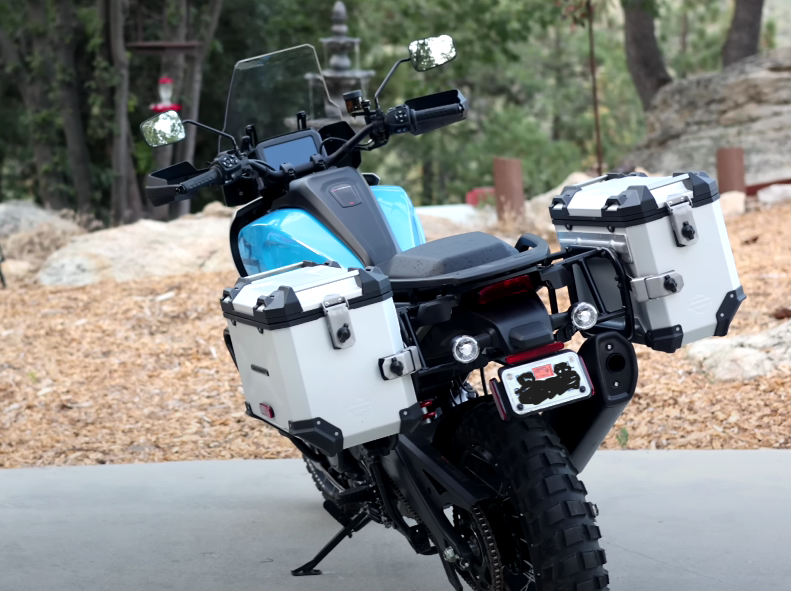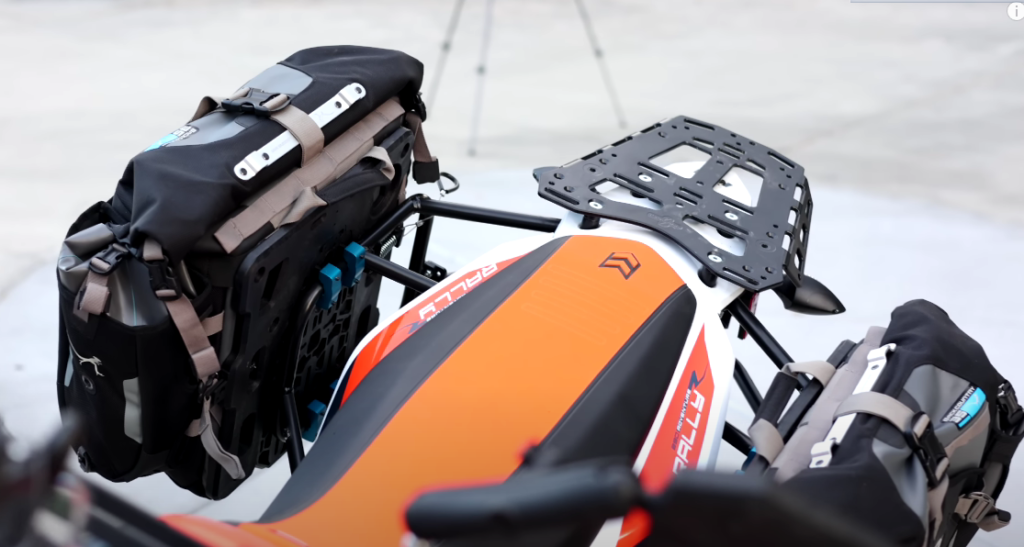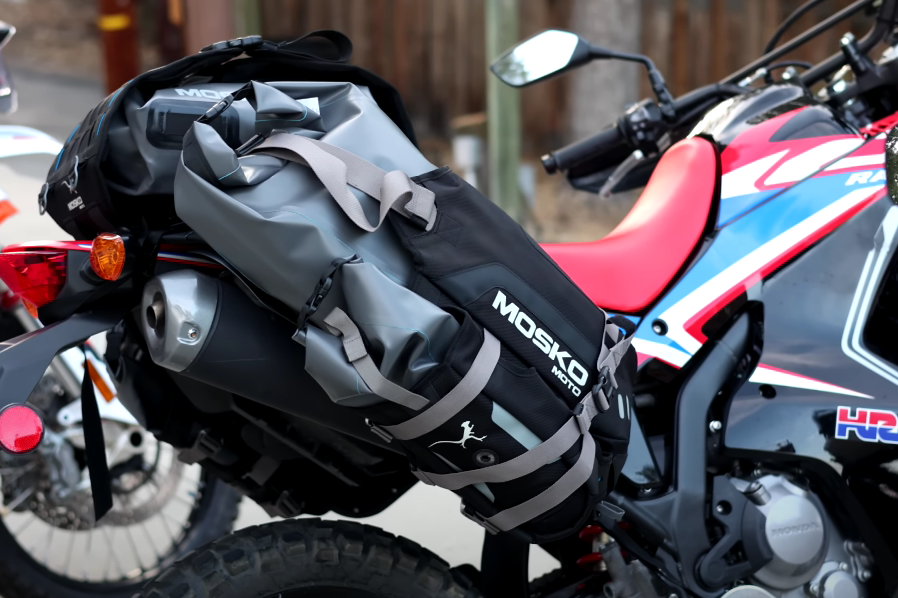Whether you’re new to adventure riding or have been doing it since before I was even born, you may have noticed that there are more choices for adventure motorcycle luggage now than ever before. Today’s article will be very straightforward and, I hope, somewhat brief. I have three different adventure bikes. three different luggage setups: hard panniers, rackless soft luggage, and rack-mounted soft panniers. I’ll briefly walk you through the main benefits and drawbacks of each of these three systems to help you decide which might be right for you on your adventure bike.
1. Hard Metal Panniers

Benefits
- Ease of Access: The number one benefit, I think, is how easy they are to get in and out of. Simply turn your key, open your latch, and you have access to your contents. Easy in and out.
- Locking Mechanism: Another benefit is that they lock. However, anyone with a little crowbar or even a screwdriver can probably pop these things open or even pop them off the bike completely. So don’t be fooled; they’re not as secure as you might think.
- No Straps: Another benefit of these bags is that there are no straps. With the other bags I’ll show you, there are straps everywhere—straps through the frame of the bike, straps to secure and tighten everything down. You don’t have to deal with any straps with a system like this, so no soft straps flapping around, getting caught in the bike, or needing to be cinched down and rolled up.
- Versatility: Another benefit of the hard boxes is that you can pull them off the bike and use them as a chair. If you’re camping somewhere without a table, they’re very useful for things like that.
Drawbacks
- Width and Drag: One of the biggest drawbacks is how wide they make the motorcycle. The width can be a problem if you’re filtering lanes or splitting traffic. It also creates more wind drag, which reduces fuel economy. Additionally, if you’re traveling on narrow trails, they can stick out quite a bit more than the handlebars.
- Durability: Another significant drawback, in my opinion, is that they’re not very good at taking crashes or damage. If you drop the bike or have an off-road accident—which you likely will if you do adventure riding—they may not go back on the mounts properly. They could twist, making it difficult to close or compromising their waterproofness. They really aren’t good at handling crash damage.
- Safety Concerns: Perhaps the biggest downside to hard boxes is that they can be very dangerous in awkward riding situations if your legs get swept back into the boxes. This has happened to many riders, leading to broken legs or ankles. This risk is especially high in challenging terrain where your leg can get caught between the box and the ground or the foot peg. For this reason, I don’t recommend them if you plan on doing a lot of off-roading.
2. Rack-Mounted Soft Panniers

Benefits
- Quick Release: One of the biggest advantages is that most modern soft panniers have quick-release systems. For example, with this bag, all I do is pull it off, and the bag is off. To reinstall, it just slides onto the puck. It’s even faster than hard luggage.
- Off-Road Friendly: Another significant benefit is that they are much safer for off-road riding. If you hit them with your leg or body, they’re not going to cause injury like a hard pannier might.
- Durability: These panniers can take falls and crashes extremely well. Whether crashing off-road or on-road, they won’t lose their shape, waterproofness, or ability to mount back onto the bike, unlike hard panniers after an accident.
Drawbacks
- Cost and Weight: Don’t expect to save money or weight with soft panniers compared to hard ones. Once you consider the mounting materials, brackets, and the heavy-duty nature of the bags, they’re not much lighter or cheaper than hard panniers.
- Straps: With soft bags, you’ll have to deal with multiple straps. Each time you need to secure something or access your gear, you’re handling a lot of straps, which can be cumbersome. There’s also the extra strap material that you need to roll up and manage, which can get annoying on long trips.
- Convenience: Soft panniers aren’t as convenient for quick access. For example, if you have something in the side pods, you need to unclip and unbuckle several straps before you can get to your gear. While Moskomoto has done a good job minimizing this hassle, it still isn’t as easy as just popping open a hard pannier.
- Security: Another possible downside is the perceived lack of security. As I mentioned, hard panniers aren’t as secure as they look. With soft bags, yes, someone could cut them open or try to remove them from the bike, but the reality is that if someone wants to steal your stuff, they will, regardless of whether you have hard or soft panniers. Soft bags may make it a bit easier or faster for someone to take your gear.
- Width: A potential downside to this system is that it’s not much narrower overall, as they still use a pannier rack. While they might be slightly narrower than hard bags, they’re still relatively wide due to the necessary spacing from the motorcycle’s bodywork and exhaust.
3. Rackless Luggage Systems

Benefits
- No Rack Required: The Mosko Moto Reckless 80 is an excellent example of rackless luggage. They also make a 40-liter version, and there’s a similar product by Tusk called the Highland Reckless system, which I recommend if you’re on a budget. The main benefit of rackless luggage is that you don’t need to install pannier racks on your motorcycle.
Pannier racks add extra cost and need to be bolted onto your bike. While racks can offer crash protection and keep luggage off the bodywork, not needing a rack means you can use these bags on nearly any motorcycle. You can even travel with these bags on a rented or borrowed bike.
- Narrow Profile: Another advantage is that rackless luggage keeps the bike as narrow as possible. Without the racks to space out the bags, you maintain a narrower overall width, likely not much wider than the handlebars, even with an 80-liter system like the Mosko Moto Reckless 80. This is particularly beneficial for off-roading, filtering traffic, or if you simply don’t like having bags sticking out from the sides.
Handling: Another benefit I found in my own testing, comparing racked bags to rackless bags, is that rackless systems keep the weight closer to the center of mass.
